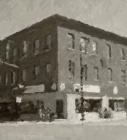1
"THE SIMONS FAMILY"2
Simons and Patterson family lots1860s
Old Durham Road, Priceville, Ontario, Canada
 Credits:
Credits:Historical Atlas of Grey and Bruce Counties Ontario by H. Belden & Co. 1880
3
The Simons FamilyWhen the census taker came through in 1851, the Simons family were in residence on lot#7 SDR (South of the Durham Road) and likely also lot#8. They were from the United States and may have come to the Durham Road by way of the Queen's Bush settlement on the Garafraxa Road. Chauncey was 47 years old and Mehatable was 40 years old. They had four children, Rozel (aged 20), Christopher (aged 16), Charles (aged 13) and Rosannah (aged 10). In 1855, Chauncey received the crown patent for lot#7 SDR, while his oldest son Rozel received the crown patent for lot#8.
There are two poignant references to this family. The first is that their son, Christopher, died in 1854, likely of the typhoid that swept through the area that year. He was buried in the cemetery and his headstone is one of the four that were recovered. He was nineteen years old.
4
Christopher Simons grave stone1854
Old Durham Pioneer Cemetery
 Credits:
Credits:South Grey Museum, Flesherton, ON
5
The second is a passage in Broken Shackles: Old Man Henson From Slavery to Freedom, in which Henson recounts the story of how he came to Grey County. While living in Lockport, NY, he was visited by Chauncey Simons who had gone to the United States to convince fellow Black refugees to come to Artemesia Township in Grey County where he resided. This was in 1853. According to Henson, Chauncey gave a glowing report of life in the township:"The hills of Artemesia are full of the best gravel for making roads. Its woods of fine building timber and full of pheasants, pigeons, fox, deer and black bear. Its pebbly streams swarm with speckled trout, the finest fish in the world. These and her little lakes are the home of the mink, marten, otter, beaver and wild duck. On their banks, cherries, nuts and berries of many sorts grow wild. Its wild plum orchards, loaded in the spring with the prettiest of white and pink blossoms, bear abundance of fruit. Its beaver meadows supply wild hay for the cattle. Its maple trees give sugar and its soil yield fine wheat and other grains and splendid vegetables. Thus are the wants of the settler well provided for. Right there is the great Cuckoo Valley, stretching from the big Artemesia Falls far away to the Blue Mountains and Georgian Bay, presenting scenery that must please all lovers of the picturesque, the grand and beautiful. My friends, it is a wonderful land. It's the finest country I ever clapped my eyes onto, and reminds me of what the paradise of our first parents must have been." (Page 190 ...)
Chauncey was successful in his mission to convince Henson and others to return with him to the Durham Road. As it turned out, there was no free land available for Henson. Chauncey accompanied Henson to Owen Sound, arriving there on St. Patrick's Day, 1854. Both men found work and lodgings. Chauncey left his farm for his family to tend.
He is listed in the 1861 census as a labourer, suggesting that he continued to work in Owen Sound. His son Rozel, then 26 years of age, is listed as the farmer, along with Charles (aged 23, a labourer) and Rosannah (19 years old). All three grown children are residing with their mother, Mehatable.
In the 1871 census, Mehatable is listed as a widow, living with her two sons, Rozel (aged 36) and Charles (aged 33). Rosannah has left the family home and may have married Caesar Augustus Johnson, another Black settler in Artemesia.
In 1856, Rozel sold Lot#8 to John Frost, a White Owen Sound businessman with abolitionist leanings. It is quite likely that he continued to farm the land until Frost sold it to Edward Patterson in 1862.
6
Lot #8, SDR, (South side of the Durham Road) Land registrycirca 1863
Old Durham Road, Priceville, Ontario, Canada
 Credits:
Credits:Grey Roots Museum and Archives, Owen Sound, ON
7
"THE PATTERSON FAMILY"8
Edward Patterson came to Canada in 1855 from Maryland where it is assumed he had been enslaved. He found his way to Owen Sound where he took up lodgings at Coulson`s Hotel.9
Coulson's Hotel as it is today2012
Owen Sound, Ontario, Canada
 Credits:
Credits:South Grey Museum, Flesherton, ON
10
In the 1861 census Edward Patterson is listed as a labourer. Likely with the aid of John Frost, he purchased lot #8SDR. The historical record locates Edward Patterson on the Durham Road AND in Owen Sound. In various documents he is listed as a labourer, hostler, stagecoach driver, farmer and a lay preacher.11
Simons and Patterson family lots1860s
Old Durham Road, Priceville, Ontario, Canada
 Credits:
Credits:Historical Atlas of Grey and Bruce Counties Ontario by H. Belden & Co. 1880
12
Edward (Ned) Pattersoncirca 1880
Owen Sound, Ontario, Canada
 Credits:
Credits:Grey Roots Museum and Archives, Owen Sound, ON